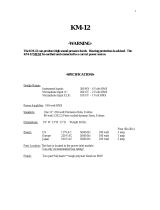
EFFECTS LOOP (Continued)
When panned hard left
(7:00), mostly lows will
pass this junction. When the rotary control is swept toward
HIGH, the crossover will allow more of the upper harmonic
range to receive processing. Panned hard right (5:00), mostly
highs will be present in the loop's signal path. With the
CROSSOVER control set straight up (12:00), the whole range of frequencies
(lows and highs) pass equally through the EFFECTS LOOP. The MIX Control
lets you decide how much of the frequency specific affected signal you
wish to blend with the dry (unaffected) signal. Panned hard left, (0%)
removes all the wet signal from the mix. Panned hard right (100%) allows only
the wet signal to pass the MIX Control. In general, its always a good idea to set
up your signal processor with its mix control at 100% wet and then slowly raise
MIX MODE
TUBE
TUBE
HI GAIN
TUNER
OUTPUT
BALANCED
LEVEL
MUTE
GAIN
FOOTSWITCH
CHANNEL SELECT
FOOT
SWITCH
EXT
FET
FOOTSWITCH
FUNCTION ASSIGN
0%
100%
SEND
RETURN
EFFECTS LOOP
CROSSOVER
FX LOOP AUTO
LOW
HIGH
MIX
OFF
ON
TUBE
FET
MIX
MODE
the M-2000 's FX LOOP MIX Control until you reach the desired blend. This scheme preserves the integrity of the attack and
punch characteristics the M-2000 is capable of delivering (when no processing is being used.) Finally, the FX LOOP AUTO
ASSIGN rotary control activates the loop as well as allowing you to engage it automatically in any of the three Modes when they
are called up with either the CHANNEL SELECT Rotary Control or the FOOT CONTROLLER.
NOTE A great way to check out the power of this advanced loop is to try this simple exercise:
1. Connect your favorite signal
processor to the SEND and RETURN (Input to SEND - Output to RETURN.) May we humbly suggest a "chorus" program as these
seem to be great for the purpose of this exercise.
2. Set the signal processor's Dry / Wet Blend to 100% Wet. 3. Sweep the
CROSSOVER control to approximately 3:00 (this will allow mostly high frequencies to be processed.)
4. Use the FX LOOP AUTO
assign rotary to activate the loop in the Mode that you wish to play in.
5. While playing an open string, slowly increase the FX
LOOP MIX control until you reach the desired dry / wet blend.
Right away you should be able to appreciate the fact, that, while you have chorus (or whatever effect you choose) on "top" of your
sound, you have not lost the punch and authority that is so often sacrificed when using effects...especially less expensive units that
don't incorporate high quality operational amplifiers in their mixer and output stages. At this time you may also want to sweep the
CROSSOVER control over to 9:00 to experience the same test passing mostly low frequencies through the loop. While quite
different and interesting, we think most players will want to process their highs, keeping the bottom end tight with unprocessed
definition.
PAGE 11
SPEAKER OUT
XLR and the standard 1/4 inch phono jacks. Each of these formats include a
pair of jacks that are wired in parallel and which may be used individually or
together to power additional cabinets. The recommended speaker load
impedance for the
M-2000 is 4 Ohms at which the mighty SIMUL-
STATE power section is capable of delivering a whopping 625 watts RMS
before clip, and peaks of over 2000 watts! A speaker load of 8 Ohms may
also be used and at this impedance, though the overall power will be
reduced to roughly 300 watts.
SPEAKER
OUT
SPEAKER
OUT
SPEAKER OUT
SUGGESTED LOAD 4 OHMS
600 WATTS RMS
MINIMUM LOAD 2 OHMS
SPEAKER OUT
CAUTION: NEVER BLOCK AIR VENTS
The BASIS M-2000 provides two types of
interconnects for powering speaker enclosures,





















